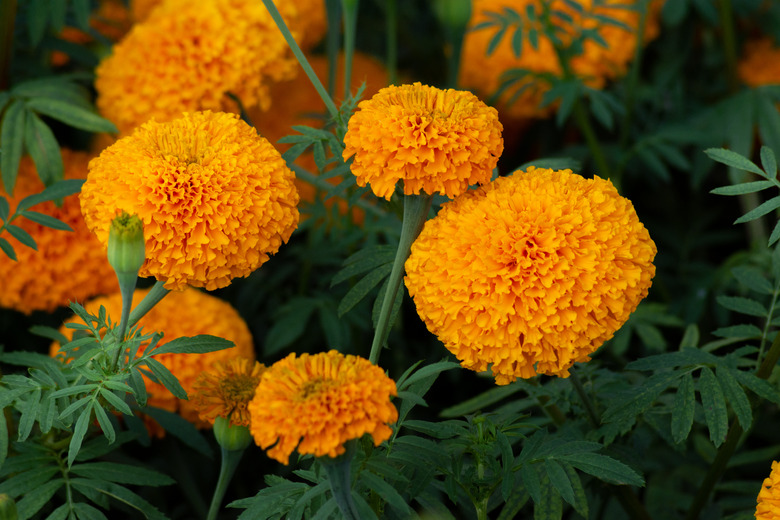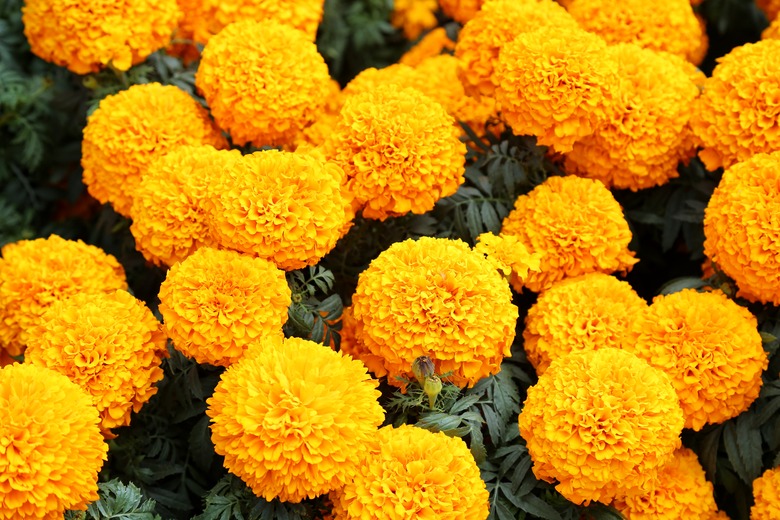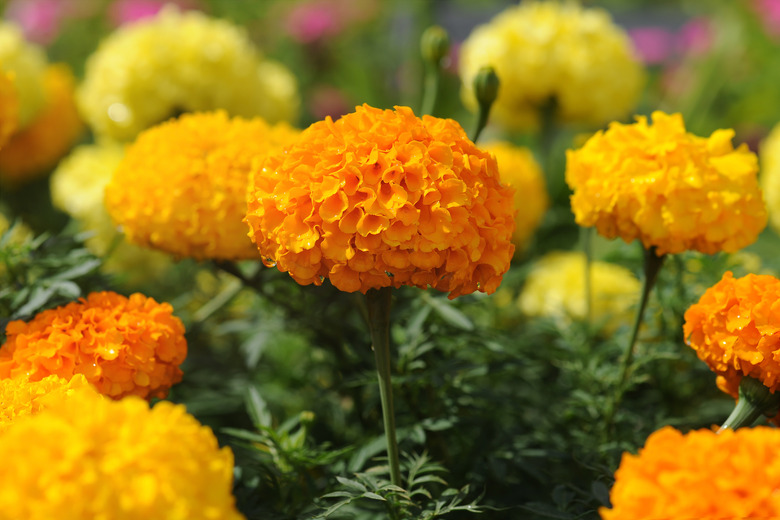How To Grow Marigolds
We may receive a commission on purchases made from links.
Cheery and easy to grow, marigolds (Tagetes) are a favorite among gardeners. There are over 50 varieties of this annual plant, but American gardeners are most likely to see the French marigold (Tagetes patuls) and African marigold (Tagetes erecta) at their local garden center. French marigolds stand 6 to 12 inches tall and spread about 6 to 9 inches wide. African marigolds are taller at 1 to 4 feet with a 2-foot spread.
Both varieties produce lovely orange, yellow and red flowerheads from spring through fall for dazzling color all summer long. Marigolds require very little care and attention, leaving you to just enjoy their beauty and not have to fuss over them too much. In addition to their ornamental value, marigolds attract beneficial pollinator insects like bees, ladybugs and butterflies.
Best Uses for Marigolds
Best Uses for Marigolds
Marigolds stay fairly compact, so you can use them as border plants or line walkways with them. You can also plant marigolds anywhere you need a pop of color in a sunny flower bed. They look nice in groups, and you can plant them in containers either alone or with other cheerful annuals.
Some gardeners also plant marigolds throughout their vegetable garden, believing them to repel insect pests. Marigolds are also said to repel rabbits and deer. Most scientists view this belief as nothing more than an old wives' tale, but some gardeners swear by it. You have nothing to lose if you decide to give it a try, so consider planting a few marigolds near your veggies and see if the trick works.
However you use your marigolds, make sure you don't eat them! Many websites list marigold flowers as edible, but they are referring to a plant called calendula, which is commonly referred to as a pot marigold. These plants are edible, but they are not actually marigolds. True marigolds in the Tagetes family can cause skin irritation, and eating them could make you quite sick.
How to Grow Marigolds
How to Grow Marigolds
- Common Name: Marigold
- Botanical Name: Tagetes
- When to Plant: Wait until after the last frost
- USDA Zones: 3-11
- Sun Exposure: Full sun
- Soil Type: Moist, well-drained soil
- When it's in Trouble: Spotted leaves, appearance of mildew on plant
- When it's Thriving: Bright flowers atop healthy green foliage
Starting Marigolds From Seed
With the exception of African marigolds, most marigolds grow easily when planted from seed. If your soil is very heavy or drains slowly, work some sand or peat moss into it to improve drainage. Generally, soil that holds puddles for more than five hours needs to be amended for better drainage. Work the soil in your desired planting area to loosen it, removing any rocks you find as you go.
If your soil is really poor, blend a 5-10-5 plant fertilizer into it as well. Marigolds are not fussy about soil and can grow too many leaves at the expense of flowers if they are overfertilized. Add fertilizer to your soil only if you have tested it and know for certain that it is extremely lacking. After working the soil, push your marigold seeds into the ground no more than an inch deep. Space your seeds about an inch apart.
Water your marigold seeds after you sow them. In just three or four days, you will have seedlings emerging from the soil, and your plant will start flowering in about eight weeks. When the seedlings emerge, thin them so the young plants are about 10 to 12 inches apart. To avoid disturbing the roots of any plants you are keeping, thin marigolds by cutting off the seedlings at ground level rather than pulling them out of the ground.
If you are growing African marigolds, be aware that they take longer to germinate and get going than other marigold varieties. You will want to start African marigold seeds indoors four to six weeks before your last frost date. You can transplant your seedlings into the garden after the last frost.
Starting Marigolds From a Seedling
Because their seeds take a little longer to get going, many gardeners opt for young nursery plants rather than seeds when growing African marigolds. Dig your planting holes large enough to accommodate the entire root ball of the young plant, spacing the plants 10 to 12 inches apart.
Marigolds that are grown in small plastic pots often experience girdling. Girdling is when a plant's roots are not able to grow out and instead start growing around the other roots in the pot. Girdling is bad news, so make sure you look for it when you plant your marigolds. If you see it, use your fingers or a knife to pull or cut away roots that are encircling the plant. This does stress the plant a bit, but it is a necessary evil for the plant's survival.
Backfill your planting holes, covering the roots completely, and then water in your new flowers. You may also wish to mulch around your seedlings to keep weeds down and reduce the competition for soil nutrients.
In What Zone Do Marigolds Grow Best?
In What Zone Do Marigolds Grow Best?
As long as you give them a sunny spot and well-drained soil, marigolds will grow anywhere in USDA plant hardiness zones 3 through 11. Marigolds tolerate both very hot summers and drought conditions well, making them an excellent choice in warm Southern gardens. Gardeners in zones 9 through 11 often report that without a killing frost, their marigolds behave like perennials.
When Should You Plant Marigolds?
When Should You Plant Marigolds?
You can plant marigolds at any time after the last expected frost in your area. This usually means around Mother's Day for those in zones 4 and 5 but can be as early as March or February in zones 8 and 9.
Soil, Sunlight and Water Recommendations for Marigolds
Soil, Sunlight and Water Recommendations for Marigolds
Marigolds just aren't particular about their soil. In fact, marigolds often bloom more in poor soil than they do in rich soil, where they often just get green and leafy and never bother to flower (the opposite of what any gardener who desires a lush, colorful garden wants). This is disheartening for gardeners who lovingly oversee every aspect of their plants' care, but it is great for those who want maximum flowers with minimal effort. As long as the soil drains well and is not rocky, your marigolds will be perfectly content.
Marigolds do their best in full sun and need little else. You may have to water them in extreme drought conditions, but Mother Nature usually supplies enough rain to keep them happy. If you do need to water, make sure you water the base of the plants and not their leaves. Wet marigolds are prone to powdery mildew. Note too that marigolds detest wet feet, so let the soil dry out completely before you water them again.
Although it is not necessary, your marigold plants will produce new flowers more quickly if you deadhead them. To deadhead marigolds, cut the spent flower off the plant just above the closest set of leaves.
How to Harvest Marigolds
How to Harvest Marigolds
If you are content to enjoy your marigolds in the garden, there is no need to harvest them at all. A bouquet of marigolds does look lovely on a windowsill or kitchen table, however. If you would like to bring your flowers inside, cut the stems to the desired length early in the morning with clean pruning shears. Make your cut just above where the stem branches off the rest of the plant.
Place your cut marigolds in a vase of warm water immediately after cutting them. To avoid fouling your vase water, strip the leaves off the bottom of the marigold stem so they are not sitting in the water. Fresh marigolds can last up to a week indoors.
You can also dry your marigolds to preserve them. To do so, pick only the most exceptional blooms. Cut the desired stems off the plant, remove the leaves and hang the marigold upside down in a dark, cool place.
Common Pests and Other Problems for Marigolds
Common Pests and Other Problems for Marigolds
Marigolds suffer from very few pests, and some gardeners even believe that they repel problem insects. Mites and aphids sometimes visit marigolds, but they are generally not problematic. If you want to get rid of them, blast them off with some water from the garden hose or spray the plants with insecticidal soap.
Common Diseases for Marigolds
Common Diseases for Marigolds
Like most garden plants, marigolds are susceptible to fungal infections and mildews. Mildews tend to appear as powdery coatings on the plants' leaves, while various fungi cause discolored spots. These issues are easily avoided by practicing good garden hygiene. Stay away from your plants when they are wet, irrigate the plants' roots rather than their leaves and keep weeds to a minimum.
It is also important that you properly space your plants so that air can circulate around them. This allows them to dry thoroughly after it rains. When pulling unwanted weeds, make sure you also clean up garden debris like fallen leaves since they hold moisture and promote fungus.
If you have a particularly rainy or damp growing season, you may struggle with mildews and fungi even if you do everything right. You can treat your plants with a fungicide if desired, but weigh the cost before treating them. Because they are inexpensive annuals, it may prove to be easier to simply write off a bad growing season and try again next year with fresh plants.
References
- Piedmont Master Gardeners: Magical Repelling Powers of Marigolds — Myth or Fact?
- Gardener's Path: How to Plant and Grow the Glorious Marigold
- Floridata: #531 Tagetes spp.
- The Old Farmer's Almanac: Growing Marigolds
- Burpee: All About Marigolds
- Garden Design: Grow Marigolds for No-Fuss Color in the Garden


